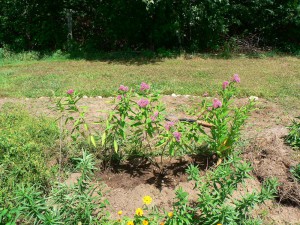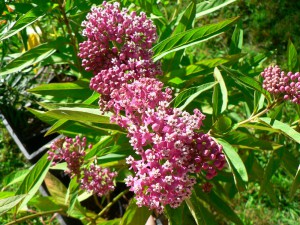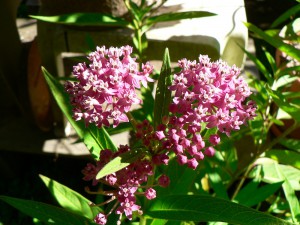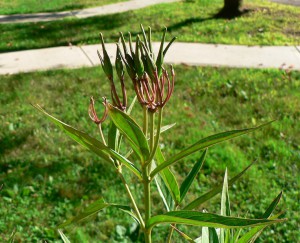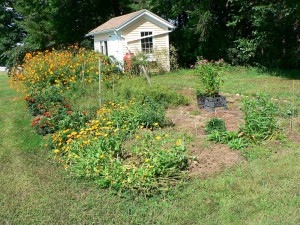I wrote earlier this year that I wanted to add Amsonia tabernaemontana and Asclepias incarnata to my fiber and dye plant garden at Bramble Hill Farm. They are both bast fiber plants native to North America. Bast fibers are found in the stems of a plant (rather than around the seeds, like cotton, for example). I was introduced to the fiber potential of amsonia by fellow flax and linen study group member, Carolyn Wetzel, who brought some gorgeous, creamy-colored fibers to a meeting one night. A. incarnata was the “mystery cordage plant” from my sister’s parking lot that she helped me identify in 2012. I have finally managed to acquire both plants!
Actually, the amsonia wasn’t too tricky to get. I had to do a little research about which of the varieties available at the nurseries nearby grew tallest. My assumption is that taller plants will create longer fibers in the stems. I bought two plants of Eastern Bluestar at Andrew’s Greenhouse earlier this spring. They were in bloom at the time with delicate, star-shaped, light blue flowers. Apparently I did not take any photos of it at the time, though, which is hard to believe. You can check out some images at the New England Wildflower Society site here. Here is one of my plants in July after the flowers died back. (12/27/2023 Edited: The New England Wildflower Society is now the Native Plant Trust, and the link above no longer works. See the new Go Botany link here for images.)
The story of the Asclepias incarnata, otherwise known as swamp milkweed, is a little longer. My sister had collected some seed for me last summer, which I planted early this spring. Nothing came up for weeks and weeks. Finally I realized something was wrong. I went to Nasami Farm, a native wildflower nursery in Whately, MA, which is part of the New England Wildflower Society. (12/27/2023 Edited: Now called the Native Plant Trust) They were out of stock at the time, but the staff person there helpfully looked it up for me to find out if the seeds needs special treatment. Yes, they do, it turns out. The seeds need to cold-stratify for four months in order to germinate. This means they need to be cold to mimic the dormancy of winter before they will germinate.
At that point, back in June, it was too late to grow any from seed this season. My options were to stick the seeds in the fridge until October, then plant them, or just to wait until fall to plant the seeds, and let them naturally cold-stratify over the winter. The third option was to buy plants. So I left my name and contact info, and they said they would call me when they got them back in stock.
Last weekend I finally got my plants! Because of the timing of their cultivation, the plants were still in bloom, even though all the milkweed around here finished blooming ages ago. They are gorgeous! I *did* manage to take some photos of the swamp milkweed.
Above you can see four plants in the bed I’ve been saving for them all summer. In front of the swamp milkweed are the two amsonia plants.
Here are some close-ups of the spectacular flowers of swamp milkweed:
You can see that the leaves are more slender and pointed than the leaves of common milkweed (A. syriaca).
This one had already begun to set seed. The seed pods are also more slender and pointy than those of the common milkweed:
Here’s a wider view of the garden at this point in the season:
The “fiber” portion of my fiber and dye plant garden is now much improved!


